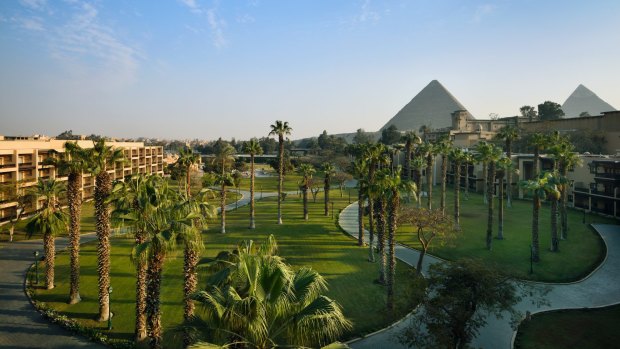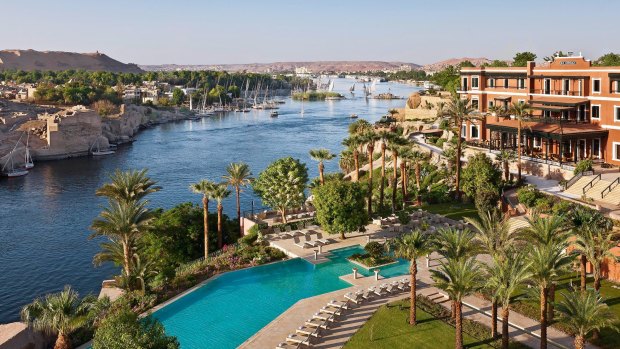This was published 5 years ago
Egypt: The luxury Egyptian hotels that are also historic treasures
By Alison Stewart

Mena House.
The grand old historic hotels strewn like pearls along the Nile Valley owe much of their lustre to Egypt's archaeological and strategic significance. Giza's Mena House, Luxor's Winter Palace and Aswan's Old Cataract – all built to enable the pursuit of treasure after the Rosetta Stone's discovery in 1799 unlocked the mysteries of hieroglyphics – are treasures in themselves, linked inextricably to momentous events in the country's history.
Constructed for the late golden age of the Grand Tour, they were present for the unearthing of fabled antiquities such as Tutankhamun's tomb. They were there during the decline of the Ottoman Empire, the rise of British influence, the building of the Suez Canal, the declaration of the country as a sovereign kingdom, the strategic construction of the Aswan High Dam, the two World Wars, the birth of the Arab Spring and the rise and fall of despots. They have welcomed kings and princes, fortune hunters, writers and politicians, celebrities and charlatans. There's even a significant Australian connection. And still they survive, as serene as the Nile, adapting only slightly to age and circumstance.
It's 25 minutes' drive from Cairo Airport to Giza through a chaotic traffic system, the workings of which are as mysterious as the Sphinx. Marriott Mena House on the edge of the Sahara is the most downstream of the Nile Valley's three gems. Built in 1869 as a hunting lodge for the Khedive Ismail, viceroy of Egypt, the hotel is a 16-hectare oasis within Giza's dusty tumult.

Sofitel Legend Old Cataract Hotel, Aswan.Credit: Fabrice Rambert
It is only as those joining Scenic's 11-day Treasures of Egypt journey gather on the terrace for drinks and canapes, however, that the true significance of Mena House's address – 6 Pyramids Road – becomes apparent. Rising majestically above us in startling proximity, and glowing rosy in the sunset as it has done for the past 4500 years, is the only surviving of the seven wonders of the ancient world – the Great Pyramid of Khufu and its smaller brother, the Pyramid of Khafre.
It's an emotional moment, slightly diminished by the extraordinary wedding celebrations that are taking place around the nearby pool. Mena House has been obliged to accept large wedding parties to compensate for dwindling tourism during post-revolution Egypt. As numbers pick up, one wonders if wedding bookings will reduce, which would be a relief for hotel guests with inadequate earplugs.
It's a relatively small price. Joining us on this terrace is a ghostly parade of the famous, the notorious and the noteworthy – Prince Albert Victor of Wales, Sir Arthur Conan Doyle, Winston Churchill, King Farouk of Egypt, Field Marshall Montgomery, the future King George V and Queen Mary, Richard Nixon, Cecil B. DeMille, Agatha Christie, Charlie Chaplin. Scenes from films such as Valley of the Kings and The Spy Who Loved Me were filmed here. Mena House was where Churchill met F.D. Roosevelt to discuss the D-Day landings. It carries a sombre antipodean link – Australian troops requisitioned the hotel during World War I and again in 1939, when Mena House became a hospital for wounded Australian troops.
It also owes much to the 1869 opening of the Suez Canal. For this event, the Khedive, who managed Egypt's shift from Ottoman jewel to independent state, enlarged his hunting lodge – today's main dining room represented the entire lodge.
Out to impress such luminaries as Austrian Emperor, Franz Joseph and other significant European royals, including the French Empress Eugenie, wife of Napoleon III, he even built a road between Cairo and the Pyramids to render Eugenie's Giza visits more comfortable. By 1883, the Khedive's lodge became "redundant" and a wealthy English couple acquired it, naming it Mena House after King Meni, Egypt's first ancient king, mentioned in the King List in the Temple of Abydos.
Two years later, another wealthy English couple bought it, again renovating, adding English-inspired great fireplaces, and enhancing the Arabic decor with fine Mashrabia work (wooden screens), blue tiles, mosaics and brass-embossed, carved wooden doors. In 1886, they opened a luxury hotel.
The Egyptian Government nationalised Mena House in 1953. Oberoi Hotels and Resorts received the management rights, recently acquired by Marriott. The hotel has 331 rooms and suites, many with Pyramid views.
Mena House joins Marriott's other Egyptian hotels (19 of them across seven brands), which include the historic Cairo Marriott and the extremely comfortable, modern Nile Ritz-Carlton on Tahrir Square, beside the Egyptian Museum and with terrific Nile and Cairo views. It is our welcome oasis in a city with a population the size of Australia's.
Progressing upstream along the Nile Valley, we fly the 1.5 hours to the ancient Egyptian capital of Luxor, ground zero for Egyptophiles. The city and surrounds holds two thirds of the ancient world's antiquities, which are still being discovered. Luxor, "the world's greatest open-air museum", is the site of the ancient Egyptian city of Thebes as well as the huge temple complexes of Luxor and Karnak.
Our resting place, the high Victorian Sofitel Winter Palace, though a little faded, is magnificent. French doors from my balcony open to the most romantic of vistas – the broad current of the Nile River, laced with lazy feluccas.
Across the fabled water is the equivalent of a gourmet feast – the tombs, temples and monuments of the West Bank Necropolis, including the Valley of the Kings and Valley of the Queens.
Travel guru Thomas Cook collaborated to build the 19th-century palace that was once the winter retreat for the Egyptian royal family. It became the lodgings of choice for travellers mesmerised by this place of dreams and desire.
It was from the hotel's grand staircase that British archaeologist Howard Carter announced his discovery of the exquisitely preserved tomb of Tutankhamun.
History accompanies us as we step inside the high-ceilinged ornate interior, with its grand staircase and gilt-and-cream pillars, then sink into plush chairs with our welcome hibiscus tea.
Again, there is a roll call of famous names. Perhaps they opened their French doors onto the Nile or the remarkable garden, as we do. Or enjoyed the afternoon tea ritual of Egypt's last king, King Farouk – macarons and scones in the Victorian Lounge. Or sipped a drink on the Nile Terrace, as did Agatha Christie, or a glass of champagne in the damask and wood-panelled Royal Bar. Or dined on tender grilled lamb and chicken in the fragrant gardens, with many of the trees more than 100 years old, like the doum palm and Indian butter tree.
In these royal gardens you will find the little Ishead, the holy Egyptian tree, a resident eagle family and beautiful feather-crested, long-beaked Hod Hod birds. On your visit to Luxor Temple, look out for the 3500-year-old illustrations of these birds.
Many others have come before – Henry Kissinger, Jacqueline Kennedy, Prince Charles and Princess Diana, Tony Blair, King Juan Carlos, George Herbert, 5th Earl of Carnarvon who financed Howard Carter – a list too long to enumerate.
Reluctantly we leave, sailing south along the Nile to Upper Egypt and our most downstream of luxury hotels, Aswan's Sofitel Legend Old Cataract.
We aren't disappointed. And the pleasure is to be found not only with the beautifully renovated historic hotel built on a buttress of pink granite overlooking the sacred river, Elephantine Island, Khnum Temple and the Aga Khan's tomb, but also with the town of Aswan.
Egypt's southernmost winter resort, 380 kilometres from the Sudanese border, inhabits a green sliver of Nile valley, shouldered by Nubian desert. Here, the desert stands in contrast to the tumble of frangipani, bougainvillea, mimosa, sycamore, African mahogany and flame trees that line the river, busy with kingfishers, herons and peewits.
The Old Cataract, the last of Scenic's "special stays", takes its name from the meeting of the river with the granite barrier that creates the Nile's first and northernmost cataract. The hotel, with its Moorish domes, Byzantine arches, hand-carved furniture, ruby chandeliers, Persian carpets and French influences, opened in 1899.
Don't be disappointed if you're not in the Palace wing, which houses the Winston Churchill and Agatha Christie suites. The once ugly New Cataract wing, built in 1960 by President Nasser to accommodate Russian consultants for the new Aswan Dam, has been remodelled into the Nile wing. Suites are luxurious and huge, with remarkable views.
It's a joy watching the desert sunset turn the Nile slate blue, before tripping off to enjoy a cocktail on the famous terrace.
Again it was that far-sighted Thomas Cook, world's first tour operator, who built the hotel for 19th-century Nile tourists. A favourite place for the British aristocracy during colonial times, it was where Agatha Christie wrote Death on the Nile, waiting for her archaeologist husband, though the other historic hotels also have claims.
A similar honour roll of guests stayed here, including Tsar Nicholas II, the Aga Khan III, the Shah of Iran, Princess Diana, kings of Jordan and Morocco, and that royal with an eye for indulgence, King Farouk.
Luxury and history – a fine combination.
Alison Stewart was a guest of Scenic.
TRIP NOTES
MORE
FLY
Etihad flies to Abu Dhabi and Egypt Air flies from Abu Dhabi to Cairo. See etihad.com
CRUISE
Scenic's 11-Day Treasures of Egypt journey from Cairo to Abu Simbel includes a four-night Nile cruise on Sanctuary Sun Boat III, four luxury hotel stays, Egyptologist tour director/guide, multiple temple, tomb and museum visits, internal flights, most meals, accommodation, tipping, complimentary wine with lunch and dinner. Prices from $9095 a person twin share, departing Giza (Cairo) on May 10, 2019. See scenic.com.au and sanctuaryretreats.com
STAY
Sign up for the Traveller Deals newsletter
Get exclusive travel deals delivered straight to your inbox. Sign up now.